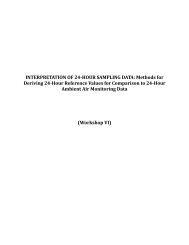Outdoor Wood-Fired Boilers - Alliance for Risk Assessment
Outdoor Wood-Fired Boilers - Alliance for Risk Assessment
Outdoor Wood-Fired Boilers - Alliance for Risk Assessment
You also want an ePaper? Increase the reach of your titles
YUMPU automatically turns print PDFs into web optimized ePapers that Google loves.
<strong>Outdoor</strong> wood-fired boilers (OWBs), sometimes called outdoor wood furnaces, or<br />
outdoor hydronic heaters vary in size ranging from 115,000 Btu/hr up to 3.2 million<br />
Btu/hr. According to sales data collected by NESCAUM (2006), the size of the most<br />
commonly sold unit is 500,000 Btu/hr. Most residential OWBs are less than 1 million<br />
Btu/hr. OWBs are used <strong>for</strong> a variety of heating purposes, most often used to heat<br />
buildings ranging in size from 1,800 square feet to 20,000 square feet. Dimensions of an<br />
OWB typically fall within three to five feet wide, six to nine feet deep, and six to ten feet<br />
tall when including the height of the chimney. OWBs contain a firebox that ranges from<br />
20 cubic feet up to 150 cubic feet. The furnaces are encased by a water jacket that is<br />
heated to 190º F. Most OWBs are not equipped with catalytic converters or secondary<br />
combustion, like those used in EPA approved indoor woodstoves. Data obtained from<br />
manufacturers by Schreiber et al. (2005) found OWBs have heating efficiencies ranging<br />
from 28 to 55 percent, with an average of 43 percent.<br />
Un<strong>for</strong>tunately, the use of OWBs in urban settings has lead to numerous complaints of<br />
health hazards (Brunsman 2006).<br />
In the absences of federal or state regulation, risk management of OWBs emissions in<br />
Ohio is the responsibility of local municipalities (OEPA, 2008). With sales trends that<br />
<strong>for</strong>ecast growing popularity of OWBs as a residential home heating option, and local<br />
OWB use in a densely populated urban setting, the City of Cincinnati requested<br />
in<strong>for</strong>mation from Toxicology Excellence <strong>for</strong> <strong>Risk</strong> <strong>Assessment</strong> (TERA) to help local<br />
policy makers select appropriate strategies to mitigate health risk. Thus, TERA<br />
conducted this screening level assessment of the potential health risks of OWBs<br />
emissions <strong>for</strong> the City of Cincinnati Office of Environmental Quality, prior to a possible<br />
regulatory action.<br />
The National Academy of Sciences (NAS 2009) describes risk assessment as a process<br />
that needs upfront planning and scoping in order to be an effective tool in a risk<br />
management decision. The appropriate upfront planning and scoping in the case of<br />
OWBs relates to the fact that even when these units are operating correctly, some<br />
distance is needed between the unit and humans in the immediate vicinity in order to<br />
prevent serious health injuries from smoke inhalation. This is likely also true of other air<br />
breathing life <strong>for</strong>ms and plants. What is also true, however, is that some low level of<br />
wood smoke can be tolerated without any, or perhaps without any significant, risk. This<br />
is because humans, even sensitive humans, and plants and animals often have sufficient<br />
defenses against chemical exposures that need to be overcome be<strong>for</strong>e toxicity ensues<br />
(Klaassen, 2007).<br />
These two basic toxicology concepts (high enough exposures cause toxicity, but lower<br />
levels can be without risk) suggest that experimental animal studies and inadvertent<br />
human exposures can be used to develop safe levels of exposure <strong>for</strong> individual chemicals,<br />
or mixtures, in various environmental media (such as ambient air). Often, these safe<br />
levels are then compared with measured or modeled chemical concentrations in order to<br />
establish whether a given exposure might be considered safe, or whether such exposures<br />
might exceed the safe concentration and perhaps be associated with some health risk.<br />
Toxicology Excellence <strong>for</strong> <strong>Risk</strong> <strong>Assessment</strong> (TERA)<br />
<strong>Outdoor</strong> <strong>Wood</strong>-<strong>Fired</strong> <strong>Boilers</strong>: A Synopsis <strong>for</strong> Urban Use<br />
6





